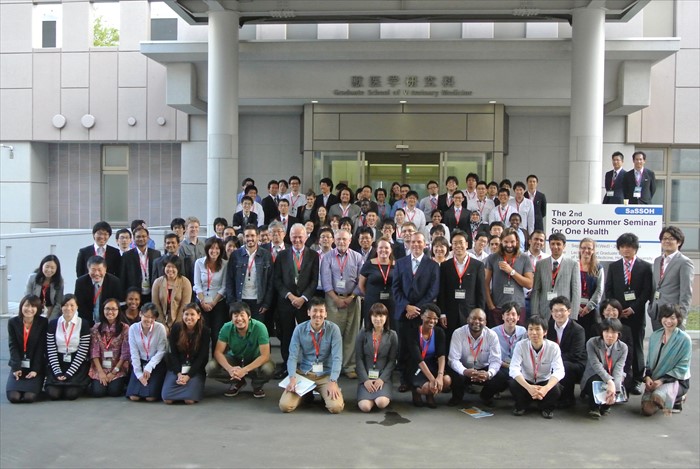- Home
- Previous SaSSOH
- The 2nd SaSSOH, 2014
The 2nd SaSSOH, 2014
The 2nd SaSSOH was the first joint symposium of “biohazard control” and “chemical hazard control” which are 2 major topics of One Health leading program. By the way, writing “SaSSOH” in Kanji id “颯爽”. The meaning of “颯爽” is emotion that we feel in a refreshing breeze. Ultimately, it expresses jauntiness, gallantry, and a smartness. We hope this symposium help the students and young scientists tackle and solve the serious problems hampering One Health in a “SaSSOH” way.

Date
September 24-25, 2014
Invited Speakers
- Mark D. Zabel
Professor, Colorado State University, Prion Research Center, USA
Peripheral prion traffic
- Keitaro Ohmori
Senior Assistant Professor, Cooperative Department of Veterinary Medicine, Faculty of Agriculture, Tokyo University of Agriculture and Technology, Japan
Possible involvement of circadian rhythms in the development of allergic diseases
- Dmitry Gerashchenko
Research Assistant Professor, VA Boston Healthcare System/Harvard Medical School. West Roxbury, USA
Slow-wave activity (SWA) regulation during sleep: role of nNOS neurons in the cerebral cortex
- Alejandro Alvarez-Prats
Postdoctoral Fellow, Section of Molecular Signal Transduction, Program for Developmental Neuroscience, National Institute of Child Health and Human development, National Institutes of Health, USA
Phosphoinositides in brain development and disease
- John P. Giesy
Professor and Canada Research Chair, Department of Biomedical Veterinary Sciences and Toxicology Centre, Western College of Veterinary Medicine, University of Saskatchewan, Canada
Perfluorinated chemicals: the history of an environmental issue
- Ariadna Garcia Saenz
PhD student of Veterinary Epidemiology, Research Centre for Animal Health, Autonomous University of Barcelona, Spain
Understanding the epidemiology of Bovine Tuberculosis in Spain
- William W. Hall
Professor of Microbiology, School of Medicine and Medical Science Centre for Research in Infectious Diseases, University College Dublin, Ireland
One Health and the role of international laboratory collaborations: The Ireland-Vietnam Blood Borne Virus Initiative (IVVI)
- Robert P. de Vries
Research Associate, Department of Cell and Molecular Biology and Chemical Physiology and Immunology & Microbial Science, The Scripps Research Institute, USA
H7N9 and H6N1 influenza A virus hemagglutinins engineered to bind human type receptors reveal a novel layer of specificity beyond the ?2-6 linkage of sialic acid
- Sonia M. Best
Investigator, Innate Immunity and Pathogenesis Unit, Lab. of Virology, Rocky Mountain Laboratories, National Institute of Allergy and Infectious Diseases, National Institutes of Health, USA
The mechanism of IFN?/? antagonism by NS5 from encephalitic flaviviruses, TBEV and WNV
Award
- Best Oral Presentation Awards
- Tomokazu Tamura (Laboratory of Microbiology, Graduate School of Veterinary Medicine, Hokkaido University)
- Junpei Kimura (Laboratory of Anatomy, Graduate School of Veterinary Medicine, Hokkaido University)
- Kazuki Heishima (Gifu University)
- Best Poster Presentation Awards
- Eugene C. Bwalya (Laboratory of Veterinary Surgery, Graduate School of Veterinary Medicine, Hokkaido University)
- Minato Hirano (Laboratory of Public Health, Graduate School of Veterinary Medicine, Hokkaido University)
- Special Award
- Keisuke Aoshima (Laboratory of Comparative Pathology, Graduate School of Veterinary Medicine, Hokkaido University)
- Best Question Award
- Minato Hirano (Laboratory of Public Health, Graduate School of Veterinary Medicine, Hokkaido University)
Organizing Committee
- Yoshinori Ikenaka
Laboratory of Toxicology, Graduate School of Veterinary Medicine, Hokkaido University
- Kenji Hosoya
Laboratory of Veterinary Surgery, Graduate School of Veterinary Medicine, Hokkaido University
- Ryo Nakao
Unit of Risk Analysis and Management, Research Center for Zoonosis Control, Hokkaido University
- Soichiro Yamaguchi
Laboratory of Pharmacology, Graduate School of Veterinary Medicine, Hokkaido University
- Takeshi Yamasaki
Laboratory of Veterinary Hygiene, Graduate School of Veterinary Medicine, Hokkaido University
- Shouta Nakayama
Laboratory of Toxicology, Graduate School of Veterinary Medicine, Hokkaido University
- Junpei Yamazaki
Laboratory of Molecular Medicine, Graduate School of Veterinary Medicine, Hokkaido University
